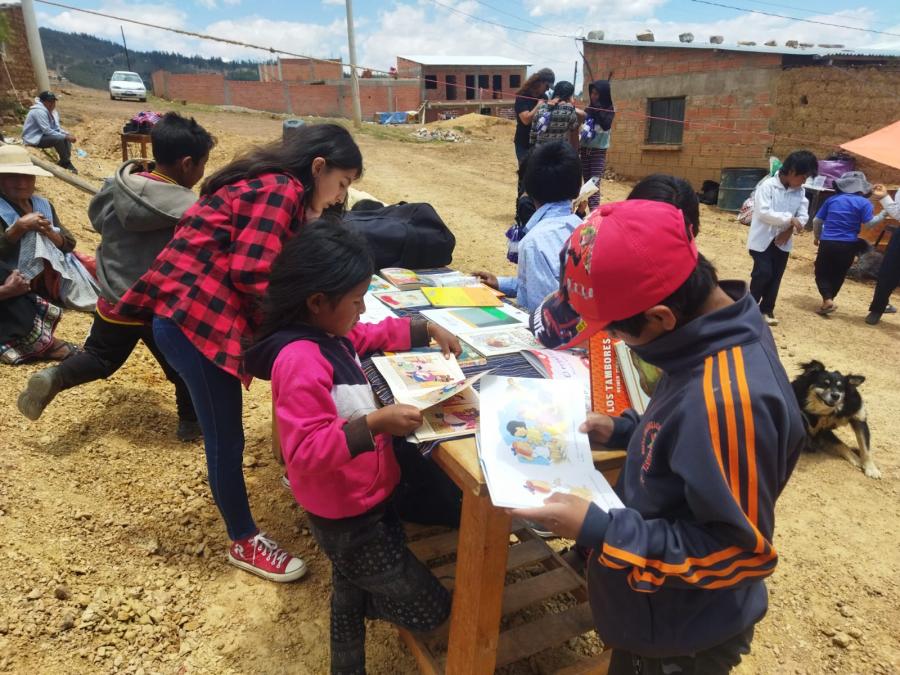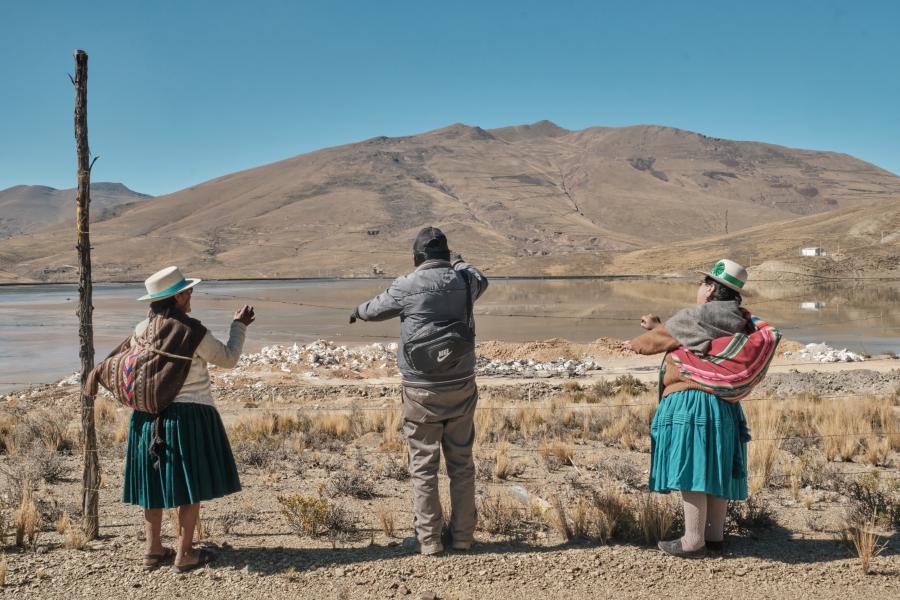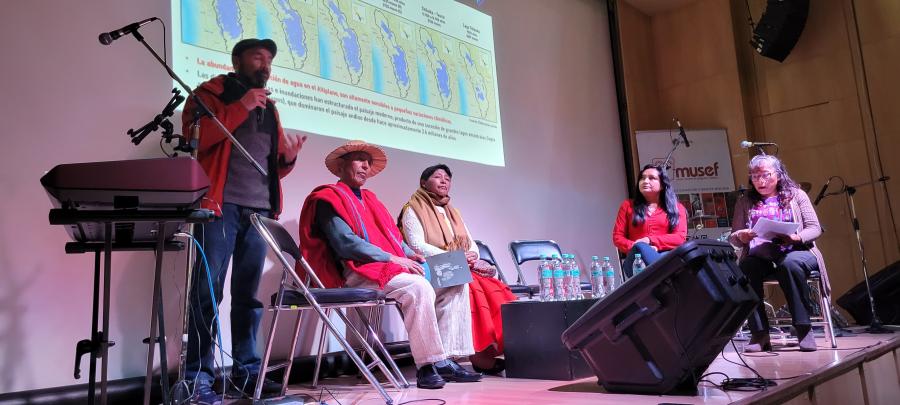Funders and festivals where indigenous media makers can find support.
Indigenous Organizations
In order to stimulate the growth of indigenous video, several independent collectives have formed in Brazil, Bolivia, Colombia, Ecuador, and Mexico. Major funding for these organizations has come through sources such as the Norwegian Agency for Development Cooperation, which supports Video nas Aldeias in Brazil. In Mexico, the Chiapas Media Project is supported through foundation grants, individual support, video sales, and video presentations. In Bolivia, a National Plan for Indigenous Audiovisual Communication has relied on non-governmental funding generated from grassroots indigenous organizations and international funds raised by nonprofit media training centers.
Many of these regional media projects form part of a larger international initiative called the Latin American Council on Indigenous People’s Film and Video/Consejo Latinoamericano de Cine y Comunicación de los Pueblos Indígenas (CLACPI). Since its creation in 1986, CLACPI has organized festivals, training workshops, and seminars devoted to strengthening the development of indigenous media in Latin America. CLACPI festivals have taken place in Mexico, Brazil, Venezuela, Peru, Bolivia, Guatemala, and Chile. Additional workshops and meetings have been organized in Cuba and Paraguay. Funding for CLACPI programs has come from the Agencia Española de Cooperación Internacional, Mugarik Gabe (an NGO in the Basque country of Spain), and the World Association for Christian Communication, with additional support from the United Nations Educational Scientific and Cultural Organization’s cultural office in Havana, Cuba, and the International Film School of San Antonio de los Baños, Cuba.
State Funds
In many Latin American countries, state-administered audiovisual grants are awarded to mediamakers on a yearly basis, but those funds are limited. Some government art funds will not support indigenous video because other funds already exist specifically for indigenous peoples. Paradoxically, state indigenous funds will not fund video because of more pressing concerns such as land rights, human rights, and political alignment to specific issues or programs. In this sense, indigenous video has no harbor within state-funded programs unless the media initiative is specifically designed and run by the state, as were the Indigenous Video Centers of Mexico, founded in the mid-1990s. To maintain their autonomy, many indigenous videomakers are resistant to accepting any state support, and write it off altogether.
In Mexico, the Fondo Nacional para la Cultura y las Artes (National Fund for Culture and the Arts) and Consejo Nacional para la Cultura y las Artes (National Council for Culture and the Arts) awards grants to indigenous videomakers to create work or attend festivals. The Agencia Española de Cooperación Internacional (Spanish Agency for International Cooperation) has an indigenous program. The agency (http://www.aecid.es/es/) has regional offices in Africa, the Americas, Asia, and Europe. Some U.S. states also have arts funds that may support American Indian works.
Indigenous Funds
Few global organizations involved in indigenous or community development have invested in media. Self-generated, locally circulated media is illegal in many places because it is considered interference on commercial broadcast spaces. International funders where indigenous peoples may go for support include the World Banks’ Global Fund for Indigenous Peoples and the Inter-American Development Bank’s Indigenous Fund, which has funded indigenous media in the past through CLACPI programs.
Festivals
Several film festivals screen indigenous works, but few have funds that are accessible to the community of indigenous videomakers. A few have provided workshops either for script development, production, or post-production. In Mexico, film festivals such as Contra el Silencio Todas las Voces, Geografas Suaves, and the Morelia International Film Festival, regularly select indigenous videos for their programming. Increasingly, other Latin American festivals have been programming indigenous media into their selections.
Other international festivals that feature indigenous work include National Geographic’s All Roads Film Project (http://events.nationalgeographic.com/all-roads/all-roads-discontinued/), which hosts several evenings of international film each year and features seed grants for indigenous and under-represented filmmakers, master classes on production, and networking sessions for project filmmakers. The ImagineNative Film and Media Arts Festival in Montreal, Canada, promotes, advances, and fosters emerging and established Canadian Aboriginal filmmakers and media artists in an international context. The Pacifika festival (www.pacifika.org), held annually in New York City by the Hawai’i Cultural Foundation, features films made by indigenous peoples from throughout the Pacific. The Native American Film and Video Festival of the Smithsonian Institute’s National Museum of the American Indian provides English subtitles for selected works when necessary and has a bilingual website devoted to Native media, including an extensive list of indigenous-themed film festivals (www.nativenetworks.si.edu).
Foundations
The development of indigenous media around the world has relied heavily on grants and fellowships from foundations. Following is a list of foundations that have supported indigenous video work in Latin America, and others that support independent film work:
• The Angeles Arrien Foundation for Cross-Cultural Education and Research
International scholarship for the preservation of cultural heritage, multicultural bridging and collaborative efforts, elder, and youth support. www.angelesarrien.com
• Daniele Agostino Foundation
The foundation’s primary focus is the well-being of the women and children in Indian communities in Mexico and Guatemala. mysite.verizon.net/vze24rgj
• Ford Foundation
Grants or loans that build knowledge and strengthen organizations and networks. Twelve offices worldwide. www.fordfound.org
• John Simon Guggenheim Memorial Foundation
Provides fellowships for advanced professionals in all fields (natural sciences, social sciences, humanities, creative arts) except the performing arts. www.gf.org
• The Rockefeller Foundation
Media Arts Fellowships encourage the production, distribution, and exhibition of independent media in all forms.https://www.rockefellerfoundation.org/bellagio-center/creative-arts-fellowships/
• Cultural Contact: US/Mexico Fund for Culture
Bi-national grant program for the arts. https://wiki.creativecommons.org/wiki/Grants
• Solidago Foundation
Supports nonprofit organizations in the U.S. and in Mexico working on economic, environmental, and electoral justice issues. www.solidago.org
• Unitarian Universalist Service Committee
Nonsectarian organization that promotes human rights and social justice worldwide. http://www.uusc.org/
• World Association for Christian Communication
Worldwide membership organization working on media reform and communication for development. www.wacc.org.uk
Media-Focused Funders
• Documentary Educational Resources
Produces, distributes, and promotes quality ethnographic and documentary films from around the world. www.der.org
• Color of Film Collaborative
Works as a model to support people who have an interest in creating new and diverse images of people of color in film, video, and the performing arts.
www.coloroffilm.com
• Association of Independent Video and Filmmakers
A membership organization serving local and international film and videomakers. www.aivf.org
• Media Alliance
Media resource and advocacy center for media workers, nonprofit organizations, and social justice activists. www.media-alliance.org
• National Association of Media Arts and Culture
Association of nonprofit organizations and individuals committed to furthering the media arts: film, video, audio, and digital. www.namac.org



